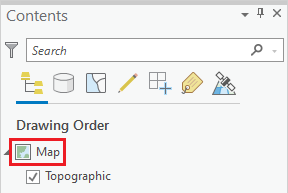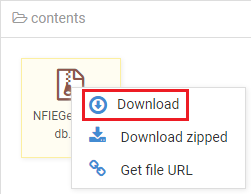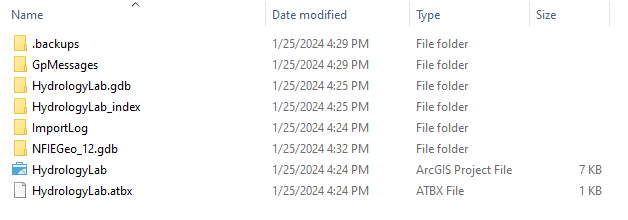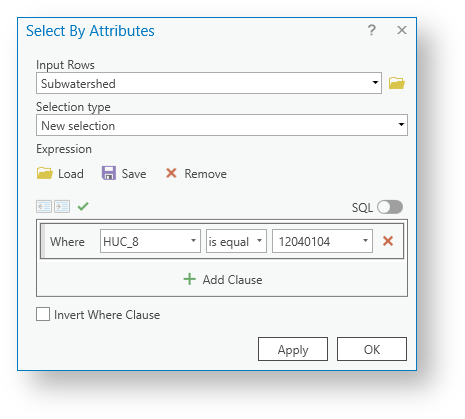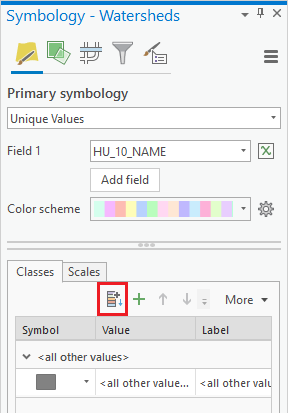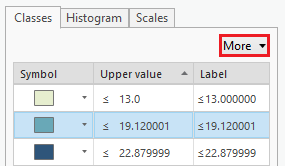| Info |
|---|
This guide was created by the staff of the GIS/Data Center at Rice University and is to be used for individual educational purposes only. The steps outlined in this guide require access to ArcGIS Pro software and data that is available both online and at Fondren Library. |
Table of Contents
| Info |
|---|
The following text styles are used throughout the guide: Explanatory text appears in a regular font.
Folder and file names are in italics. Names of Programs, Windows, Panes, Views, or Buttons are Capitalized. 'Names of windows or entry fields are in single quotation marks.' "Text to be typed appears in double quotation marks." |
| Info |
|---|
The following step-by-step instructions and screenshots are based on the Windows 10 operating system with the Windows Classic desktop theme and ArcGIS Pro 3.2.0 software. If your personal system configuration varies, you may experience minor differences from the instructions and screenshots. |
...
In this lab, you will practice downloading, manipulating, mapping, and analyzing publicly available hydrology data from a variety of online websites to study the Buffalo-San Jacinto watershed subbasin, which encompasses the greater Houston region. Specifically, you will work with watershed and flowline data from the National Flood Interoperability Experiment (NFIE), stream gauge data from the National Water Information System (NWIS), and soils data from the Soil Survey Geographic Database (SSURGO).
Part 1: Setting Up a GIS Project
Creating a new project folder
...
downloading, manipulating, mapping, and analyzing publicly available hydrology data from a variety of online websites to study the Buffalo-San Jacinto watershed subbasin, which encompasses the greater Houston region. Specifically, you will work with watershed and flowline data from the National Flood Interoperability Experiment (NFIE), stream gauge data from the National Water Information System (NWIS), and soils data from the Soil Survey Geographic Database (SSURGO).
Part 1: Creating a New GIS Project
On the Desktop, click the Start menu and select ArcGIS > ArcGIS Pro.
- If the 'ArcGIS Sign In' window appears, sign in using your Rice organizational account. (Detailed Instructions)
- In the ‘ArcGIS Pro’ window, under the 'New' section, select the Map template.
- In the ‘Create a New Project’ window, for 'Name', type " HydrologyLab ".
- For 'Location', click the Browse button.
Navigate to the location in which you would like to store your HydrologyLab project folder and click OK.
Info A project folder is where you will store all of the files associated with this lab assignment. When working in a public computer lab environment, we recommend saving your work on an external
...
USB drive. If you wish to nest your project
...
folder inside other folders
...
on your USB drive,
...
or if you are using the hard drive on personal computer, ensure that no spaces or special characters are used anywhere along the entire file path of your project folder. The default project location on your personal computer is C:\Users\[ username ]\Documents\ArcGIS\Projects.
In order to connect to a folder, you often have to be able to select the folder from the file browser on the right, rather than in the Navigation pane on the left. For example, if you wanted to store the project on an external USB F:\ drive, you would need to single-click Computer in the Navigation pane on the left and then single-click F:\ in the file browser on the right.
- Using Windows Explorer, navigate to the location where you would like to locate your project folder (likely the E: or F: drive).
Info If you
- Create a new folder inside your selected location and name it “HydrologyLab”. Remember not to use any spaces. Note the full file path of your HydrologyLab folder.
Connecting to a project folder
Now that you have created a project folder for this lab, you will need to create a new ArcGIS Pro project in it.
- On the Desktop, click the Start menu and select ArcGIS > ArcGIS Pro.
- If the 'ArcGIS Sign In' window appears, sign in using your Rice organizational account. (Sign in to Rice ArcGIS Organizational Account) In the ‘ArcGIS Pro’ window, under the 'New' section, select the Map template.
- In the ‘Create a New Project’ window, for 'Name', type "HydrologyLab".
- For 'Location', click the Browse button.
- Navigate to the location HydrologyLab folder created. Once the HydrologyLab folder is selected, click OK.
- Uncheck Ensure Create a new folder for this projectproject is checked.
- Click OK.
Because you created a new project using the Map template, the project opens with a single map already created; however, it is generically named Map, so you will give it a more descriptive name to differentiate it from the maps created in future labs.
- In the Contents pane, click Map once to select it. Then, click directly on the Map text a second time and rename it " Lab1Hydrology ".
Part 2: Mapping Watershed Data
Downloading NFIE data
Your project folder and geodatabase have been created, so you are ready to download your first set of online GIS data. You will start by downloading data from the National Flood Interoperability Experiment (NFIE), which is searchable on the ArcGIS Online platform.
...
- If necessary, in the 'Filters' section on the left sidebar, toggle off Only search in Rice University, at which point the proper layer should appear.
- Click the NFIE-Geo Regions web map.
- On the right, click to Open in Map Viewer.
- On the map, click to select the Texas-Gulf region, which encompasses Houston.
- In the table in the pop-up, next to Hydroshare, click More info View.
- In the Content section, right-click the NFIEGeo_12.gdb.zip file and select Download.
- Navigate to the location where the zipped file has been downloaded.
- Right-click the downloaded NFIEGeo_12.gdb zip file and select Extract All….
- In the ‘Extract Compressed (Zipped) Folders' window, click Extract.
- In the new extracted folder window that opens, right-click the extracted NFIEGeo_12.gdb folder and select and Copy.
- Navigate back to your HydrologyLab folder.
- Paste the NFIEGeo_12.gdb folder directly inside your HydrologyLab folder. Do NOT paste them inside the HydrologyLab.gdb geodatabase.
- Ensure that your HydrologyLab folder appears as shown below.
- Return to ArcGIS Pro.
Adding feature data in
...
ArcGIS Pro
Unfortunately, any changes you make to files outside of ArcGIS Pro are not automatically reflected inside ArcGIS Pro. Since you just added new files to your HydrologyLab folder folder, you will may need to refresh your your HydrologyLab folder in order for them to appear.
- In the Catalog pane on the right of the map view, expand Folders, right-click your your HydrologyLab folder, and select Refresh.
- Expand the the HydrologyLab folder > > NFIEGeo_12.gdb geodatabase > > Geographic feature dataset to preview what feature classes, or layers, it contains.
Drag the the Geographic feature dataset from the Catalog pane into the Lab1Hydrology map view.
...
- In the Contents pane, right-click the the Subwatershed layer and select Attribute Table. Expand the size of the table, if desired.
You will notice three of the columns are labeled HUC_8, HUC_10, and HUC_12, which correspond to the subbasin, watershed, and subwatershed codes respectively. HUC stands for hydrologic unit code, which is a unique identification number assigned to each hydrologic unit in the United States. Further to the right, you will see additional columns containing the actual names of the HUC-10 watersheds and HUC-12 subwatersheds.
- Close the Subwatershed attribute attribute table.
Adding an online basemap
...
- In the Contents pane, uncheck the the StreamGage, Flowline, Catchment and and Waterbody layers, leaving only the Subwatershed layer visible.
...
- In the Contents pane, click the the Subwatershed layer layer to select it.
- On the ribbon, click the Feature Layer contextual Appearance tabtab.
- In the Effects group, type “60” to change the transparency of the layer.
Now the basemap should be visible beneath the subwatersheds.
...
- On the Map tab, click the Select by Attributes button.
- In the 'Select By Attributes' window, use the ‘Input Rows’ drop-down menu to select the Subwatershed layer, if necessary.
- Use the ‘Selection Type’ drop-down menu to select New selection.
- Click New expression.
- For the first two fields, select HUC-8 , and is equal to .
- Type "12040104" in the last field.
- Verify that your ‘Select By Attributes’ window appears as shown below and click OK.
- In the Contents pane, right-click the Subwatershed layer and select Selection > Zoom To Selection.
...
- For ‘Output Name’, type “ SubwatershedsNew ”.
- Ensure your ‘Export Features’ window appears as shown below and click OK.
Since you’ve exported the particular subwatersheds of interest, you may now remove the master Subwatersheds layer from your map.
...
- For ‘Input Features’, drag in the SubwatershedsNew layer from the Contents pane or select the SubwatershedsNew option from the drop down box.
- For ‘Output Feature Class’, rename the feature class from “SubwatershedsNew_Dissolve” to “ Subbasin ”.
- For ‘Dissolve_Field(s)’, select the HUC_8 field, since this is the field containing the common subbasin value you wish to dissolve on.
- Ensure your ‘Dissolve’ tool appears as shown below, and click Run.
- In the Contents pane, toggle the new Subbasin layer off and on to get a better idea of the result of the Dissolve tool.
- In the Contents pane, right-click the Subbasin layer and select Attribute Table.
...
- In the Contents pane, right-click the Watersheds layer and select Symbology.
- In the Symbology pane, use the 'Primary symbology' drop-down menu to select Unique Values.
- Use the ‘Field 1’ drop-down menu to select the HU_10_NAME field.
- Use the ‘Color Scheme’ drop-down menu to select the color ramp of your choice.
- On the bottom half of the Symbology pane, if only one category called <all other values> is listed, as shown below, click the Add all values button.
...
Create an 8.5" x 11" layout clearly delineating the subbasin and watersheds on top of a basemap, with the symbology and labels corresponding to the watersheds. You may need to further adjust the order of your layers in the Contents pane and their symbology.
Part 3: Mapping Flowline Data
...
- At the top left of your Layout view, click the Lab1Hydrology map tab to return to your map view.
- In the Contents pane, check the Flowline and Catchment layers to make them visible.
...
- On the ribbon, click the Map tab.
- In the Selection group, click the Select By Location button.
- For ‘Input Features’, use the drop-down menu to select the Flowline layer.
- Use the second 'Input Features' drop-down menu to select the Catchment layer.
- For ‘Relationship’, use the drop-down menu to select Have their center in. (This setting ensures that catchments and flowlines which share the outside border with the subbasin will not also get selected.)
- For ‘Selecting Features’, use the drop-down menu to select the Subbasin layer.
- Ensure your ‘Select by Location’ window appears as shown below and click OK.
All of the flowlines and catchment areas that are within the subbasin are now selected.
...
- At the top left of your map view, click the Layout tab to return to your layout view.
- On the ribbon, click the Insert tab.
- In the Graphics and Text group, click the Rectangle text button.
- Drag a rectangle on your map layout to insert a rectangle text element.
...
- Return to the Lab1Hydrology map view.
- Open the Flowlines Symbology tab.
- Use 'Primary Symbol' drop down menu to select Graduated symbols.
- Use the ‘Field’ drop-down menu to select the Q0001C field, which contains the mean annual flow.
- Click the line next to Template to change the symbology of your flowlines.
- Save your project.
FOR MAP LAYOUT TO BE TURNED IN
The flowlines should have graduated symbology based on their mean annual flow.
Part 4: Mapping Stream Gauge Data
...
- Return to the Layout view.
- On the ribbon, click the Share tab and click the Layout button in the Export group to open the Export Layout pane on the right.
- In the Export Layout pane, use the 'File Type' drop-down menu to select PDF.
- For 'Name', type "Lab 1 Hydrology" and click Export.
- Save your project.
FOR MAP LAYOUT TO BE TURNED IN
The stream gage site locations should be added to the map layout.
Part 5: Mapping Soils Data
...
- Click the SSURGO Downloader web mapping application.
- On the right side of the webpage click the View Application button.
- In the search bar in the top corner, type "Houston, TX".
- Click in the Buffalo-San Jacinto subbasin to select it and click the Download link.
- Right-click on your downloaded BuffaloSanJacinto_12040104.ppkx file and select Show in folder. Copy the file.
- Navigate back to your HydrologyLab folder.
- Paste the BuffaloSanJacinto_12040104.ppkx file directly inside your HydrologyLab folder. Do NOT paste it inside the Hydrologylab.gdb geodatabase.
- Single-click the .ppkx file to select it and press Enter.
...
- On the bottom half of the symbology pane, click the More drop-down button and select Formal all symbols.
- Use the ‘Outline Color’ drop-down menu to select No Color.
- Click Apply.
...
- What is the average available water storage (cm) in the Buffalo-San Jacinto subbasin?
- Based on your previous calculation of the area of the subbasin in km2, what volume of water (km3) could potentially be stored in the top 1 m of soil in the Buffalo-San Jacinto subbasin if the soil were fully saturated with water?
Deliverables
- Create an 8.5 x 11 layout with the following layers limited to the subbasin:
...
- What is the average available water storage (cm) in the Buffalo-San Jacinto subbasin?
- Based on your previous calculation of the area of the subbasin in km2, what volume of water (km3) could potentially be stored in the top 1 m of soil in the Buffalo-San Jacinto subbasin if the soil were fully saturated with water?
...


